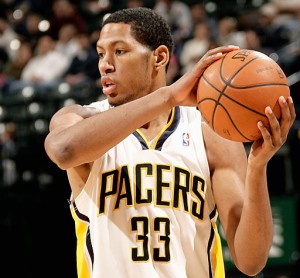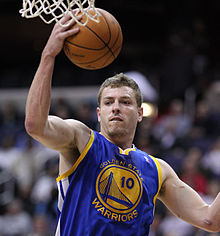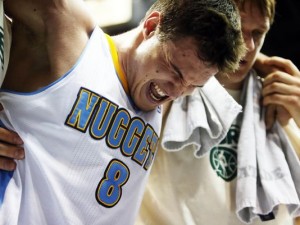 DANNY GRANGER: This is a huge season for Granger, who is on the outside looking in as far as Indiana’s future is concerned. The Pacers got within one win of the NBA Finals without him, primarily due to the supernova-like development of Paul George – who was Granger’s backup a year ago – from role player to All-Star. Now George has an $80 million extension in his back pocket, while Granger is entering the last year of a deal that makes him seem cost ineffective. But if Granger can show that he is totally recovered from the knee injury that limited him to five games last season and accept what is certain to be a different role than when he last played, it will help both the Pacers and bring some clarity to his future. He has been going full speed for nearly a month and is expected to be ready for Opening Night.
DANNY GRANGER: This is a huge season for Granger, who is on the outside looking in as far as Indiana’s future is concerned. The Pacers got within one win of the NBA Finals without him, primarily due to the supernova-like development of Paul George – who was Granger’s backup a year ago – from role player to All-Star. Now George has an $80 million extension in his back pocket, while Granger is entering the last year of a deal that makes him seem cost ineffective. But if Granger can show that he is totally recovered from the knee injury that limited him to five games last season and accept what is certain to be a different role than when he last played, it will help both the Pacers and bring some clarity to his future. He has been going full speed for nearly a month and is expected to be ready for Opening Night.
ANDREW BYNUM: He has not played since May 21, 2012 due to his problematic (degenerative?) knees, and no one knows if he will ever play again, which explains why he has changed teams twice since he last took the court. If healthy and anywhere close to what he shown in the past, Bynum could transform the improved Cavaliers into a very dangerous team, especially in the weaker Eastern Conference. But the 76ers were hoping the very same thing a year ago, and he never suited up for them. Bynum is currently doing treadmill work, not cleared for contact, with no timetable for his return. But unlike Philadelphia, Cleveland has minimal risk here: Bynum gets $6 million regardless of his condition, another $6 million if he isn’t waived by the contract guarantee date in early January and another $12.5 million if his team option for 2014-15 is picked up. If Bynum has not played by the guarantee date, that doesn’t mean the Cavs should let him go. But if there is any setback of any kind in his recovery between now and then, the Cavaliers should immediately cut bait and send a message to the other players that this will be the roster moving forward, sans Bynum.

DAVID LEE: The hip injury he suffered in his first career postseason game was worse than he thought, even though he played through the pain for five more playoff games. He is fully recovered following offseason surgery, which presents somewhat of a dilemma for the Warriors. When Lee sat during the postseason, Golden State was a better team on both ends of the floor, using Harrison Barnes as an undersized power forward to spread the floor. At the same time, Lee is a double-double machine, and the Warriors rely on his rebounding, especially given Andrew Bogut’s propensity for injury. He also has an enormous contract (3 years, $43 million remaining) that makes him hard to move despite his All-Star status.
KEVIN LOVE: He is coming off a lost season in which he played just 18 games due to a variety of ailments, twice breaking his right hand before having season-ending knee surgery. He is reportedly weighs less than 240 pounds, spent the summer doing yoga and is in the best shape of his career, which should reduce the burden on his knee. The Timberwolves have spent the last two offseasons rebuilding the roster around Love in hopes of making the playoffs and preventing him from opting out and flying the coop in the summer of 2015. Now it is up to him to stay healthy and give Minnesota a fighting chance in the loaded Western Conference.
J.R. SMITH: The Knicks said they knew about the Sixth Man Award winner’s knee issues before they re-signed him to a three-year, $18 million deal in July. If so, then why didn’t they insist he have the surgery immediately after they were eliminated from the playoffs by Indiana? Smith had to have a torn lateral meniscus repaired, which requires three to four months of recovery. That means New York’s No. 2 offensive option may not be back until mid- to late November, and that’s not counting the five-game NBA suspension he has to serve for violating the anti-drug program. If Smith misses the first month and Andrea Bargnani has trouble adjusting to the bright lights and big city, Carmelo Anthony might be taking 35 shots a game. That can’t be good for coach Mike Woodson, who has a new GM to impress.
DANILO GALLINARI: He went down in early April with a left knee injury that required two surgeries – one to repair  a torn meniscus and another in June to repair a torn ACL. Reports of his projected return have ranged from as early as December to as late as February. This is the most serious injury in a career full of injuries for Gallinari, who has missed 191 of 476 possible games in six years. A better two-way player than he is given credit for, he is Denver’s best shooter and best small forward and will be missed on both fronts by a team that is trying to assimilate a handful of new pieces with a new coach and new philosophy. The small forward slot will be filled primarily by Wilson Chandler. The shooting will not be replaced by anybody.
a torn meniscus and another in June to repair a torn ACL. Reports of his projected return have ranged from as early as December to as late as February. This is the most serious injury in a career full of injuries for Gallinari, who has missed 191 of 476 possible games in six years. A better two-way player than he is given credit for, he is Denver’s best shooter and best small forward and will be missed on both fronts by a team that is trying to assimilate a handful of new pieces with a new coach and new philosophy. The small forward slot will be filled primarily by Wilson Chandler. The shooting will not be replaced by anybody.
LOU WILLIAMS: The torn ACL he suffered in mid-January was by far the most significant injury of his career. Given his reliance on quickness, change of direction and crossover moves, he needs to be completely recovered to fill the role the Hawks need from him, which is to provide scoring off a questionable bench and play both guard spots. Right now, Atlanta’s shooting guards are the unproven John Jenkins and Jared Cunningham and its backup point guard could be slender rookie Dennis Schroeder. He is not expected to fully participate at any time during preseason and there is still no timetable for his return.
Chris Bernucca is a regular columnist and the managing editor of SheridanHoops.com. Follow him on Twitter.